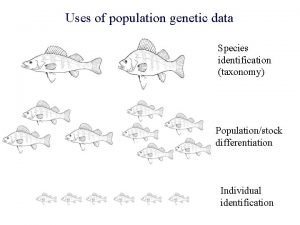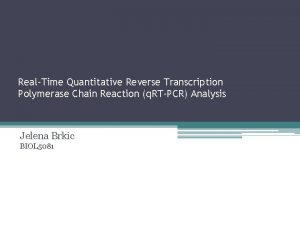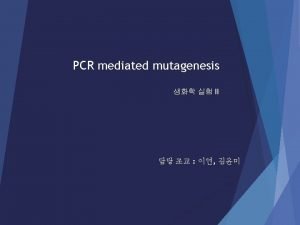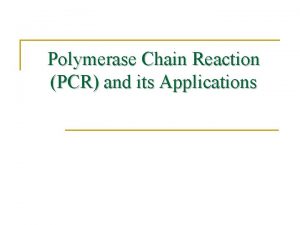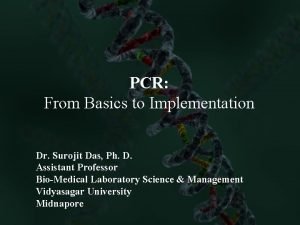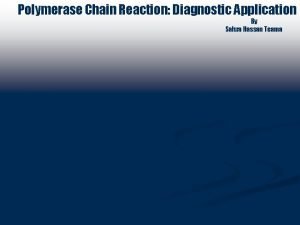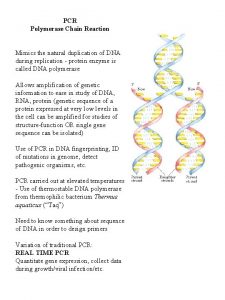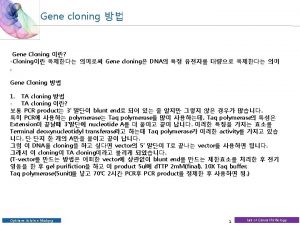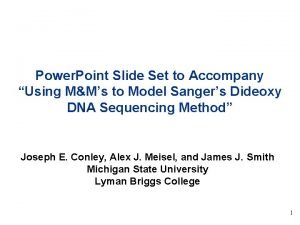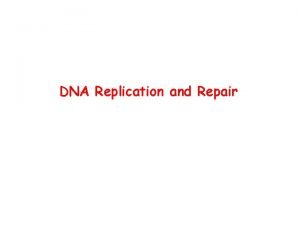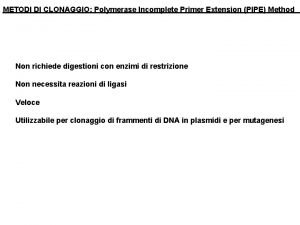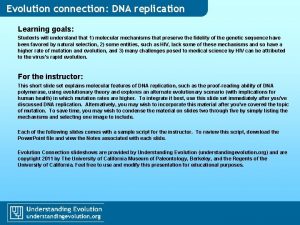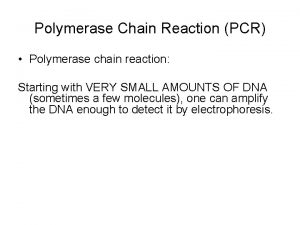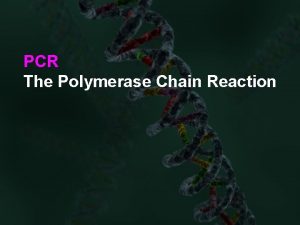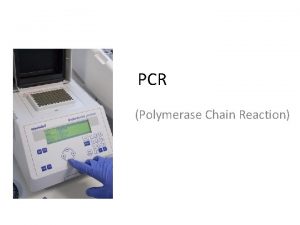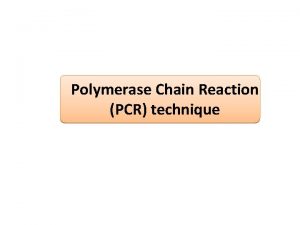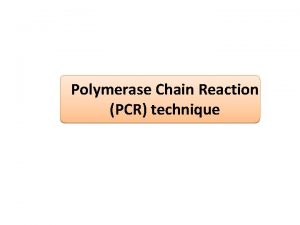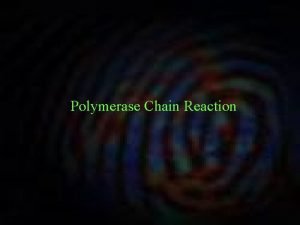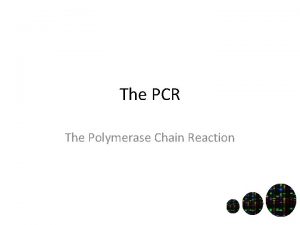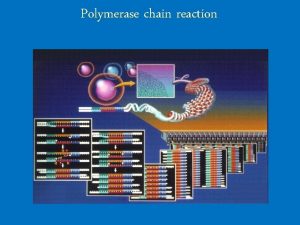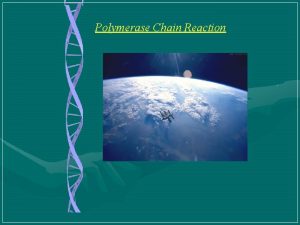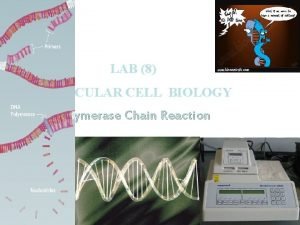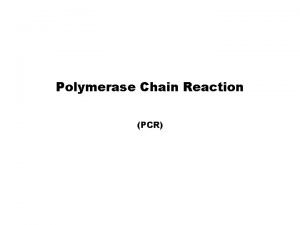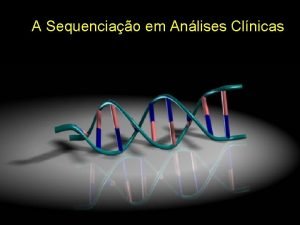Polymerase chain reaction Contents Polymerase chain reaction Reaction






















- Slides: 22

Polymerase chain reaction

Contents: - Polymerase chain reaction - Reaction components - Steps involved - Factors for optimal PCR - PCR applications - PCR modifications - Advantages - PCR limitations

- PCR is an exponentially progressing synthesis to generate large quantities of the defined target DNA sequences in vitro. - It was invented in 1983 by Dr. Kary Mullis, for which he received the Nobel Prize in Chemistry in 1993. - It is called “polymerase” because the only enzyme used in this reaction is DNA polymerase. - It is called “chain” because the products of the first reaction become substrates of the following one, and so on. - PCR targets and amplifies a specific region of a DNA strand. - Often, only a small amount of DNA is available e. g. A drop of blood, single hair, vaginal swab, seminal drop, etc. -Two methods currently exist for amplifying the DNA or making copies - Cloning: takes a long time for enough clones to reach maturity - PCR: works on even a single molecule quickly

The “Reaction” components 1 - Target DNA - contains the sequence to be amplified. 2 - Pair of primers - oligonucleotides that define the sequence to be amplified. 3 - Thermostable DNA polymerase – enzyme that catalyses the reaction 4 - d. NTPs - deoxynucleotidetriphosphates: DNA building blocks. 5 - Buffer solution – maintains p. H and ionic strength of the reaction solution suitable for the activity of the enzyme 6 - Mg 2+ as a cofactor of the enzyme

Steps involved: 1 - Denaturation: -The reaction mixture is heated to a temperature between 9098° C so that the ds DNA is denatured into single strands by disrupting the hydrogen bonds between complementary bases. - Duration of this step is 1 -2 min

2 - Annealing: - Temperature of reaction mixture is cooled to 45 -60° C - Primers are jiggling around and base pair with the sequence in the DNA. - Hydrogen bonds reform. - Annealing fancy word for renaturing.

3 - Extension: -The temperature is now shifted to 72° C which is ideal for polymerase. - Primers are extended by joining the bases complementary to DNA strands. - Elongation step continues where the polymerase adds d. NTP's from 5' to 3', reading the template from 3' to 5' side, bases are added complementary to the template. - Now first cycle is over and next cycle is continued , as PCR machine is automated thermocycler the same cycle is repeated up to 30 -40 times.

Amplification by PCR

Each cycle includes three successive steps: Denaturation 94 o. C 1 -2 minute The DNA is denatured into single strands. Annealing 34 -72 o. C 30 sec-two minute The primers hybridize or "anneal" to their complementary sequences on either side of the target sequence. Extension 72 o. C 1. 5 -3 minute The polymerase binds and extends a complementary DNA strand from each primer


Factors for optimal PCR: 1 - PCR primers - Correctly designed pair of primers to avoid mispriming (sequence should be unique) - Primer dimer, hairpin formation should be prevented - Tm, not more than 60 degree (use the proper annealing temperature). - GC Content should be in the range of 40 -60 % for optimum PCR efficiency. - Primers should end (3′) in a G or C, or CG or GC: to increase efficiency of priming. - Primers should flank the sequence of interest - Primers that match multiple sequences will give multiple products - There should be no Poly. G or Poly. C stretches that can promote nonspecific annealing

- Use hot-start: prepare reaction mixes on ice, place in preheated cycler or use a sequestered enzyme that requires an initial heat activation. 2 - DNA polymerase - Thermus aquaticus, its optimum temperature is 72° C - Taq polymerase is heat resistant - It lacks proof reading exonuclease activity 3 - Annealing temperature - Very important since the success and specificity of PCR depend on it because DNA-DNA hybridization is a temperature dependent process. - If annealing temperature is too high, pairing between primer and template DNA will not take place then PCR will fail. - Ideal Annealing temperature must be low enough to enable hybridization between primer and template but high enough to prevent amplification of non target sites. - Should be usually 1 -2° C or 5° C lower than melting temperature of the template-primer duplex

4 - Melting temperature -Temperature at which 2 strands of the duplex dissociate. - It can be determined experimentally or calculated from formula Tm = [4(G+C) + 2(A+T)] 5 - Contamination Control - The most dangerous contaminant is PCR product from a previous reaction. - Prevent exposure of pre-PCR reagents and materials to post-PCR contaminants. - Most common cause is carelessness and bad technique. - Separate pre- and post-PCR facilities. - Dedicated pipettes and reagents. - Change gloves. - Aerosol barrier pipette tips. - 10% bleach, acid baths, UV light - Dilute extracted DNA.

PCR applications: - Clinical diagnosis for disease detection - DNA typing and mapping - Cloning - Comparative study of genomics - Mutation analysis - Detection of gene expression - Site-directed mutagenesis - Sequencing - Forensic medicine In forensic testing: By amplification of DNA from a dried blood spot or one hair follicle to trace the accused person for a crime.


1 - Infectious Diseases - Detection of infectious agents, as pathogenic bacteria and viruses 2 - Cancer Detection of malignant diseases by PCR, recurrence of hematological cancers has also been evaluated and detection of micro-metastasis in blood, lymph nodes and bone marrow. 3 - Genetic Disease - Single point mutations can be detected by modified PCR techniques such as the ligase chain reaction (LCR) and PCRsingle-strand conformational polymorphisms (PCR-SSCP) analysis. - Detection of variation and mutation in genes using primers containing sequences that were not completely complementary to the template.

Prenatal diagnosis - Prenatal sexing: Often required in families with inherited sex-linked diseases. - Prenatal Diagnosis of diseases of many of the inborn errors of metabolism is possible by DNA markers. Research -PCR is used in research laboratories in DNA cloning procedures, -Southern blotting, DNA sequencing, recombinant DNA technology. - Major role in the human genome project.

II. DNA fingerprinting (DNA typing): -DNA fingerprint consists of first obtaining a sample of cells, such as skin, hair, or blood cells, which contain DNA. -The DNA is extracted from the cells and purified, amplification of the target DNA including the repetitive sequences by using PCR. The DNA was then cut at specific points along the strand with restriction enzymes. The enzymes produced fragments of varying lengths that were subjected to gel electrophoresis, the shorter the fragment, the more quickly it moved toward the positive pole (anode). The separated fragments are then transferred to a nitrocellulose or nylon filter; this procedure is called a Southern blot. -The fragments underwent autoradiography in which they were exposed to DNA probes—pieces of synthetic DNA that were made radioactive and that bound to the minisatellites. This technique is used in forensic medicine to determine the parents of an individual or suspect in a crime


Gene therapy is an experimental technique that uses genes to treat or prevent disease. The goal of gene therapy is to insert the normal, cloned DNA for a gene into the somatic cells of a patient who has a defect in that gene as a result of some diseasecausing mutation. The DNA must become permanently integrated into the patient’s chromosomes in such a way as to be properly expressed to produce the correct protein. For example, patients with severe combined immunodeficiency disease (SCID) have an immune deficiency as a result of mutations in the gene for adenosine deaminase. Patients with SCID have been successfully treated by incorporating functional copies of the appropriate gene into their cells /[Note: This is often called “gene replacement therapy. ”] Although gene therapy is an attractive therapeutic strategy for individuals with inherited diseases, but it has some limitation and drawbacks, e. g. some of the treated SCID patients developed leukemias due to activation of oncogenes. -


PCR modifications - Nested PCR - Multiplex PCR - Sequence-specific PCR - Reverse-transcriptase PCR - Long-range PCR - Whole-genome amplification - Quantitative real-time PCR - Arbitrarily Primed PCR/Random Primer PCR [RAPD PCR (AP-PCR)]. PCR Advantages - Specific, sensitive and flexible - Simple, rapid, relatively inexpensive - Amplifies from low quantities - Works on damaged DNA PCR Limitations - Contamination risk - Primer complexities and primer-binding site complexities - Amplifies rare species - Detection methods
 Polymerase chain reaction
Polymerase chain reaction Polymerase chain reaction
Polymerase chain reaction The three steps of polymerase chain reaction
The three steps of polymerase chain reaction Site:slidetodoc.com
Site:slidetodoc.com Application of pcr are
Application of pcr are Pcr phases
Pcr phases Polymerase chain reaction
Polymerase chain reaction Eltonian pyramid
Eltonian pyramid Tth polymerase rtpcr
Tth polymerase rtpcr Dna polymerase
Dna polymerase Dna replication eukaryotes
Dna replication eukaryotes Rna polymerase
Rna polymerase Exonucleolytic proofreading
Exonucleolytic proofreading Dna polymerase
Dna polymerase Types of dna polymerase in eukaryotes
Types of dna polymerase in eukaryotes Rho independent termination
Rho independent termination Polymerase incomplete primer extension
Polymerase incomplete primer extension Dna prokaryotic
Dna prokaryotic The principal enzyme involved in dna replication is
The principal enzyme involved in dna replication is Types of dna polymerase in eukaryotes
Types of dna polymerase in eukaryotes Dna polymerase
Dna polymerase Adn polymérase
Adn polymérase Replication
Replication
